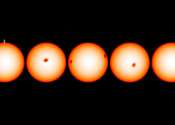Epsilon (uppercase Ε, lowercase ε or lunate ϵ; Greek: Έψιλον) is the fifth letter of the Greek alphabet, corresponding phonetically to a close-mid front unrounded vowel /e/. In the system of Greek numerals it has a value of 5. It was derived from the Phoenician letter He . Letters that arose from Epsilon include the Roman E and Cyrillic Ye.
The name "epsilon" (ἒ ψιλόν, "simple e") was coined in the Middle Ages to distinguish the letter from the digraph αι, a former diphthong that had come to be pronounced the same as epsilon.
The uppercase form of epsilon looks essentially identical to Latin E. The lowercase version has two typographical variants, both inherited from medieval Greek handwriting. One, the most common in modern typography and inherited from medieval minuscule, looks like an inverted "3". The other, also known as lunate or uncial epsilon and inherited from earlier uncial writing, looks like a semicircle crossed by a horizontal bar. While in normal typography these are just alternate font variants, they may have different meanings as mathematical symbols. Computer systems therefore offer distinct encodings for them. In Unicode, the character U+03F5 "Greek lunate epsilon symbol" (ϵ) is provided specifically for the lunate form. In TeX, \epsilon () denotes the lunate form, while \varepsilon () denotes the inverted-3 form.
There is also a Latin epsilon or "open e", which looks similar to the Greek lowercase epsilon. It is encoded in Unicode as U+025B ("Latin small letter open e", ɛ) and U+0190 ("Latin capital letter open e", Ɛ) and is used as an IPA phonetic symbol. The lunate or uncial epsilon has also provided inspiration for the euro sign (€).
The lunate epsilon (ϵ) is not to be confused with the set membership symbol (∈), nor should the Latin uppercase epsilon (Ɛ) be confused with the Greek uppercase sigma (Σ).








